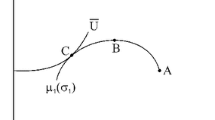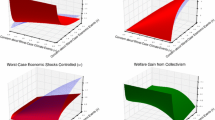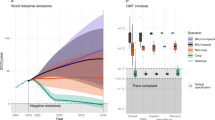Abstract
This article presents an analysis of the behaviour of countries defining their climate policies in an uncertain context. The analysis is made using the S-CWS model, a stochastic version of an integrated assessment growth model. The model includes a stochastic definition of the climate sensitivity parameter. We show that the impact of uncertainty on policy design critically depends on the shape of the damage function. We also examine the benefits of cooperation in the context of uncertainty: We highlight the existence of an additional benefit of cooperation, namely risk reduction.






Similar content being viewed by others
Notes
Here we do not raise the issue of countries’ incentive for cooperation. For such an analysis, see, e.g. [13].
The objective function is linear if the agent is risk neutral, but the constraints are always linear in the decision variables.
The parameter value is discretized in three values.
Recently, the expected utility model has been challenged in the context of uncertainty, and several alternatives have been proposed to represent ambiguity aversion and probabilities misperceptions. For the role of these models in the case of climate change, see for instance [5, 16, 32]. However, the expected utility model is a useful benchmark which has hardly been studied in IAMs. It is natural to take this approach as a starting point.
In contrast, not taking the transform u −1 would yield the objective function \(W_i=u\left(\sum_{t=1}^T\frac{Z_{i,t,s}}{(1+\rho)^{t-1}}\right)\) in the deterministic case, which looks quite unusual.
Specifically, the simulation horizon is 2330.
For short, we use the term country to denote the regions/countries of the S-CWS model.
For the list of variables and the complete description of the model, see the “Appendix”.
Values for those polynomials have been updated from the DICE-2010 model.
In the terminology of dynamic noncooperative games, this is an open loop Nash equilibrium. Closed loop or feedback Nash equilibria have also been introduced in dynamic core-stability analysis in [37], albeit with a simpler model.
A third kind of scenario can also be computed, namely the partial agreement Nash equilibria with respect to a coalition scenarios (PANEs). Each PANE is the outcome of a subset of countries maximizing jointly their welfare, while the others act individually (there are as many such scenarios considered as there are coalitions). See [15, 36] for applications with PANEs.
The CWS model has been initially developed for coalition analyses that need a huge number of model runs. The limited size of the generated problem was then a main constraint. In that sense, CWS is different from other growth models such as WITCH or DICE that are more detailed, but also less manageable.
This phase could also be used to contrast several approaches, for instance models with different values of S.
In a multistage context, the computation set should be aggregated in a tree to be exploited by the model.
There is no optimization, only computation using the optimal policy found.
Empirically, it is well-known that the result of stochastic programming optimization, or prediction value, is very optimistic and, in a sense, not realistic and that the policy found is very sensitive, not robust.
θ 3 = 2.0 is the benchmark value in the CWS model as well as in many IAMs.
Indeed, if the relationship between global emissions and damages is convex, we know by Jensen’s inequality that damages from expected emissions are lower than expected damages from emissions. Therefore, there are additional incentives to reduce emissions when risk is explicitly taken into account. The opposite is true when the relation is concave.
References
Ambrosi, P., Hourcade, J.-Ch., Hallegatte, S., Lecocq, F., Dumas, P., & Ha-Duong, M. (2003). Optimal control models and elicitation of attitudes towards climate damages. Environmental Modeling and Assessment, 3, 133–147.
Arrow, K. J. (2009). A note on uncertainty and discounting in models of economic growth. Journal of Risk and Uncertainty, 38(2), 87–94.
Atkinson, G., Dietz, S., Helgeson, J., Hepburn, C., & Sælen, H. (2009). Siblings, not triplets: Social preferences for risk, inequality and time in discounting climate change. Economics: The Open-Access, Open-Assessment E-Journal, 3(26), 1–28.
Bahn, O., Haurie, A., & Malhamé, R. A. (2008). A stochastic control model for optimal timing of climate policies. Automatica, 44(6), 1545–1558.
Basili, M., Chateauneuf, A., & Fontini, F. (2008). The precautionary principle as a rule of choice with optimism on windfall gains and pessimism on catastrophic losses. Ecological Economics, 67, 485–491.
Bellman, R. (1957). Dynamic programming. Princeton: Princeton University Press.
Ben-Tal, A., Golany, B., Nemirovski, A., & Vial, J.-Ph. (2005). Retailer–supplier flexible commitments contracts: A robust optimization. Manufacturing and Service Operations Management Approach, 7, 248–271.
Ben-Tal, A., & Nemirovski, A. (2002) A robust optimization—methodology and applications. Mathematical Programming Series B, 99, 453–480.
Birge, J. R., & Louveaux, F. (1997). Introduction to stochastic programming. New York: Springer.
Bosetti, V., Carraro, C., Galeotti, M., Masseti, E., & Tavoni, M. (2006). WITCH: A world induced technical change hybrid model. The Energy Journal, 13–38.
Bosetti, V., & Tavoni, M. (2009). Uncertain R&D, backstop technology and GHGs stabilization. Energy Economics, 31, 18–26.
Bosetti, V., Tavoni, M., Carraro, C., & Sgobbi, A. (2009). Delayed action and uncertain stabilisation targets. How much will the delay cost? Climatic Change, 96, 299–312.
Bréchet, Th., Gerard, F., & Tulkens, H. (2011). Efficiency vs. stability of climate coalitions: A conceptual and computational appraisal. The Energy Journal, 32(1), 49–76.
Bréchet, Th., Camacho, C., & Veliov, V. (2010). Model predictive control, the economy, and the issue of climate change. Université catholique de Louvain, CORE discussion paper 2010/16.
Bréchet, Th., Eyckmans, J., Gerard, F., Marbaix, Ph., Tulkens, H., & van Ypersele, J.-P. (2010). The impact of the unilateral EU commitment on the stability of international climate agreements. Climate Policy, 10, 148–166.
Chichilnisky, G. (2000). An axiomatic approach to choice under uncertainty with catastrophic risks. Resource and Energy Economics, 22, 221–231.
Dasgupta, P. (2008). Discounting climate change. Journal of Risk and Uncertainty, 37(2–3), 141–169.
Forest, C. E., Stone, P. H., & Sokolov, A. P. (2006). Climate sensitivity constrained by temperature reconstructions over the past seven centuries. Geophysical Research Letters, 33, L01705.
Gaertner, P. S. (2001). Optimisation analysis and integrated models of the enhanced greenhouse effect. Environmental Modeling and Assessment, 6(1), 7–34.
Gollier, Ch. (2001). The economics of risk and time. Cambridge: MIT.
Gollier, Ch. (2002). Discounting and uncertain future. Journal of Public Economics, 85, 149–166.
Hegerl, G. C., Crowley, T. J., Hyde, W. T., & Frame, D. J. (2006). Climate sensitivity constrained by temperature reconstructions over the past seven centuries. Nature, 440, 1029–1032.
Manne, A., Mendelsohn, R., & Richels, R. (1995). MERGE: A model for evaluating regional and global effects of GHG reduction policies. Energy Policy, 23(1), 17–34.
Murphy, J. M., Sexton, D. M. H., Barnett, D. N., Jones, G. S., Webb, M. J., Collins, M., & Stainforth, D. A. (2004). Quantification of modelling uncertainties in large ensemble of climate change simulations. Nature, 430, 768–772.
Nordhaus, W., & Yang, Z. (1996). A regional dynamic general-equilibrium model of alternative climate-change strategies. American Economic Review, 86(4), 741–765.
Nordhaus, W. D., & Popp, D. (1997). What is the value of scientific knowledge? An application to global warming using the PRICE model. The Energy Journal, 18, 1–46.
Intergovernmental Panel on Climate Change (2007). Fourth assessment report of the intergovernmental panel on climate change 2007. Cambridge: Cambridge University Press.
Persson, T., & von Below, D. (2008). Uncertainty, climate change and the global economy. CEPR Discussion Paper 7024.
Ramsey, F. P. (1928). A mathematical theory of saving. The Economic Journal, 38, 543–559.
Roe, G., & Baker, M. (2007). Why is climate sensitivity so unpredictable? Science, 318, 629–632.
Royer, D. L., Berner, R. A., & Park, J. (2007). Climate sensitivity constrained by CO2 concentrations over the past 420 million years. Nature, 446, 530– 532.
Shaw, W. D., & Woodward, R. T. (2008). Why environmental and resource economists should care about non-expected utility models. Resource and Energy Economics, 30, 66–89.
Stern, N. (2006). The stern review on the economics of climate change. Cambridge: Cambridge University Press.
Thénié, J., van Delft, Ch., & Vial, J.-Ph. (2007). Automatic formulation of stochastic programs via an algebraic modeling language. Computational Management Science, 4, 17–40.
Thénié, J., & Vial, J.-Ph. (2008). Step decision rules for multistage stochastic programming: A heuristic approach. Automatica, 44(6), 1569–1584.
Tulkens, H., & Eyckmans, J. (2003). Simulating coalitionally stable burden sharing agreements for the climate change problem. Resource and Energy Economics, 25, 299–327.
Tulkens, H., Germain, M., Toint, P., & de Zeeuw, A. (2003). Transfers to sustain dynamic core-theoretic cooperation in international stock pollutant control. Journal of Economics Dynamics and Control, 28, 79–99.
van der Zwaan, B. C. C., & Gerlagh, R. (2006). Climate sensitivity uncertainty and the necessity to transform global energy supply. Energy, 31, 2571–2587.
von Neumann, J., & Morgenstern, O. (1944). Theory of games and economic behavior. Princeton: Princeton University Press.
Weitzman, M. (2009). On modeling and interpreting the economics of catastrophic climate change. Review of Economics and Statistics, 91(1), 1–19.
Wets, R. J.-B. (2000). Stochastic programming models: Wait-and-see versus here-and-now. Technical report, University of California.
Zapert, R., Gaertner, P. S., & Filar, J. A. (1998). Uncertainty propagation within an integrated model of climate change. Energy Economics, 20(5–6), 571–598.
Acknowledgements
The authors are grateful to Johan Eyckmans, Alain Haurie and Henry Tulkens for fruitful comments on preliminary versions of the paper. The CWS model has been developed under the CLIMNEG research project supported by the Belgian Science Policy (contract CP/05A).
Author information
Authors and Affiliations
Corresponding author
Appendix
Appendix
1.1 Regions of the CWS Model
1.2 Statement of the CWS Model
1.2.1 Variables and Parameters Definitions
1.2.2 Constraints
The index i = 1,...N stands for region/country.
1.2.3 Parameters Values
1.3 Probability Distribution
Rights and permissions
About this article
Cite this article
Bréchet, T., Thénié, J., Zeimes, T. et al. The Benefits of Cooperation Under Uncertainty: the Case of Climate Change. Environ Model Assess 17, 149–162 (2012). https://doi.org/10.1007/s10666-011-9281-3
Received:
Accepted:
Published:
Issue Date:
DOI: https://doi.org/10.1007/s10666-011-9281-3




